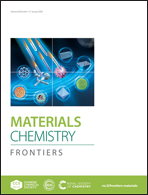Excitation-dependent efficient photoluminescence in an organic–inorganic (C4H12N)2HfCl6 perovskite induced by antimony doping†
Abstract
Organic–inorganic lead (Pb)-free halide perovskites exhibit considerable potential as photoluminescence materials because of outstanding photophysical properties. However, metal halide perovskites generally emit single self-trapped excitons at room temperature, making it difficult to achieve a wide color gamut using simple external stimuli. Herein, a novel antimony (Sb)-doped hafnium (Hf(IV))-based metal halide hybrid (TMA)2HfCl6 (TMA = C4H12N) with efficient and remarkable excitation-dependent luminescence is reported. The prepared (TMA)2HfCl6 samples exhibit two different types of emissions under varying excitation lengths that originate from free excitons and self-trapped excitons. The emissions range from red to white light and can be tuned through precise control of the excitation wavelength. The Pb-free metal halide (TMA)2HfCl6:Sb3+ exhibits a high photoluminescence quantum yield of 85.55% upon 365 nm ultraviolet excitation and excellent air stability, which are unique advantages for a light-emitting material. These results provide fundamental insights into the color kinetic features of Sb3+ in hybrid metal halides, offering guidance for expanding the application scope of luminescent metal halides.



 Please wait while we load your content...
Please wait while we load your content...